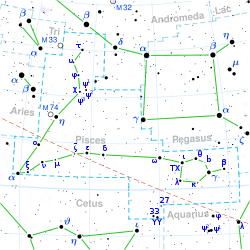Top Qs
Timeline
Chat
Perspective
Gliese 900
Hierarchical triple star system in the constellation Pisces From Wikipedia, the free encyclopedia
Remove ads
Gliese 900 (GJ 900, BD+00 5017) is a triple star system, located 68 light-years from Earth in the constellation Pisces. It is made up of three main sequence stars: one is a K-type star, the two others are M-dwarf stars. The two M-dwarfs form a binary system with a period of 36 years, and this system has a period of 80 years around the primary component. With an apparent magnitude of 9.546, Gliese 900 is not visible to the naked eye. A widely separated planet has been detected around the system.[8]
Remove ads
Stellar system
Summarize
Perspective
Gliese 900 is a hierarchical star system, made up of three main sequence stars: The primary component (Gliese 900 A) is a K5-K7 type star, that has 0.64–0.67 times the mass of the Sun,[3] 0.72 times its radius,[6] and 12% its luminosity.[5] A light curve from the Transiting Exoplanet Survey Satellite (TESS) shows that its rotational period is 12 days.[8] Gliese 900 A has a high level of chromospheric and coronal activity, although its apparent brightness presents little variation.[9] The other components are red dwarf stars. Gliese 900 B has a spectral type of M3–M4 and a mass between 0.24 and 0.34 solar masses. Gliese 900 C has a spectral type of M5–M6 and a mass between 0.16 and 0.24 solar masses.[3]
The system is young, about 200 million years old, and is a likely member (99.7% probability) of the nearby moving group Carina-Near.[10] It is a source of X-ray emission, with an observed flux of 9.13×102 mW M-2, and is also a source of ultraviolet emission.[8] The emission of X-rays is typical of young stars, and classifies it as one.[9] The TESS light curve identifies stellar flares on this star.[8]
Orbit
Gliese 900 B and C form an inner pair (named Gliese 900 BC) with an orbital period of around 36 years.[7] Gliese 900 BC and Gliese 900 A orbit the system's center of mass with a period of 80 years.[3][8] As of November 2004,[update] B was separated from A by 751 milliarcseconds and C was separated from A by 708 mas. This separation changes over time.[3] It was identified as a multiple star system in 2002 by Eduardo L. Martín, using adaptive optics-corrected images at the 8.2 m Subaru Telescope. When first observed, the A–B and A–C separations were of 0.51 and 0.76 arcsecs respectively.[9] A further study by Malogolovets et al. (2007) identified this system as a hierarchical triple.[3]
Other stars in the system
Malogolovets et al. (2007) reported two other objects in 2MASS images (potentially late red dwarfs) that would be the components D and E and make the system quintuple, being "very likely" to be bound to the system.[3] However, these faint stars haven't been confirmed as members of the GJ 900 system, and are likely not associated.[8]
Remove ads
Motion
Gliese 900 is located 68 light-years from Earth, based on parallax measurements by the Gaia spacecraft.[5] The BP-RP spectra suggest a distance of 67.7 ly.[5] The space velocity components of this system are U = −28.7, V = −15 and W = 0.2.[11] Gliese 900 is part of the thin disk population of the Milky Way.[11][3] It was once classified as part of the IC 2602 supercluster.[9] A newer analysis using kinematics from the Gaia spacecraft suggest that Gliese 900 has a 99.7% chance of being a member of the Carina-Near moving group and a 0.3% chance of being a field star, i.e. not associated to any star cluster or stellar association.[8]
Remove ads
Planetary system
Summarize
Perspective
A 2024 study led by Austin Rothermich identified CWISE J233531.55+014219.6 (abbreviated to CW2335+0142) as a proper motion companion to Gliese 900, with 99.5% probability.[8] This object, also called Gliese 900 b or Gliese 900 (ABC)b,[12][13] is a planetary-mass object that has 10.5 times the mass of Jupiter (0.01 times the mass of the Sun), a spectral type T9[8] and a temperature of 500 K.[14] It was found to be at an angular separation of 587" from Gliese 900. At the estimated distance to this system, it translates to a projected separation of 12,000 AU.[8]
As of 2024[update], Gliese 900 b has the largest observed separation of any known planet, and assuming a circular orbit, the longest orbital period.[15][16][c] The orbital period is estimated at 1.27 million years based on the projected separation.[17] Due to the similar spectral type, orbital separation and age, Gliese 900 b has been compared to COCONUTS-2b by the discovery team.[8]
Also in 2024, a study using data from Wide-field Infrared Survey Explorer found a red W2-W3 color for Gliese 900 b, which the researchers interpret as a sign of low gravity for T-dwarfs. Low gravity is often seen as an indicator of a young age and a low mass.[14]
See also
- Circumtriple planet, a category of planets to which Gliese 900 b belongs
- List of exoplanets discovered in 2024 - including Gliese 900 b
Notes
- Using the angular separation and the parallax (both in milliarcseconds), the physical separation (in AU) can be obtained.
444/48.17 = 9.217 AU. - Out of objects with a planetary mass (<13 MJ). Exoplanet databases list a few brown dwarfs at larger separations.
Remove ads
References
Wikiwand - on
Seamless Wikipedia browsing. On steroids.
Remove ads


